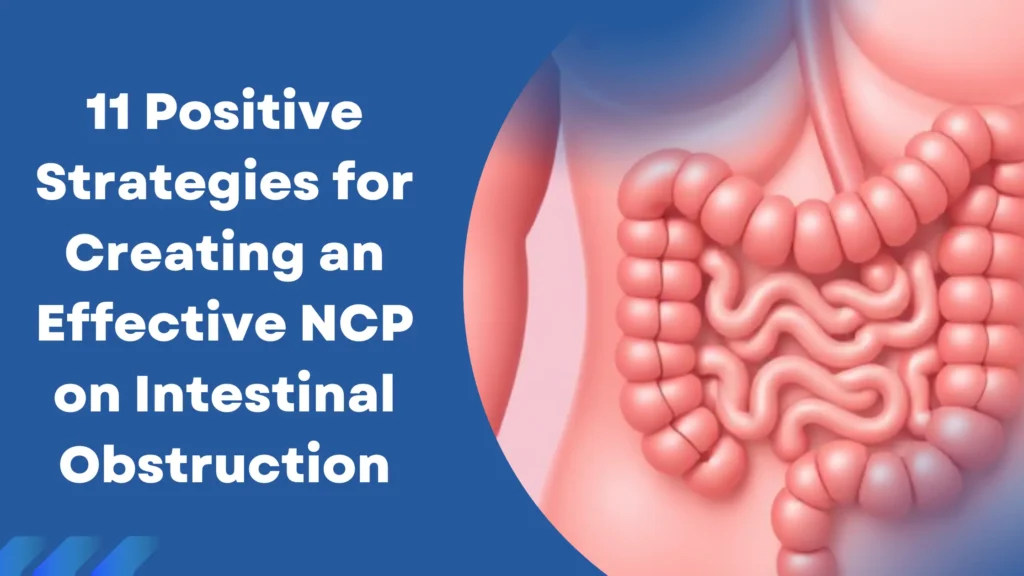NCP on Intestinal Obstruction: Creating a nursing care plan (NCP) for intestinal obstruction may seem challenging at first, but with a clear approach, you can turn it into an achievable and rewarding task. As a nursing student, you already know how essential it is to tailor the care plan to meet the specific needs of your patients. Let’s dive into understanding intestinal obstruction, crafting an NCP, and ensuring you excel in your studies.
Thank you for reading this post, don't forget to subscribe!
Introduction: What Is an NCP on Intestinal Obstruction?
Intestinal obstruction is a medical condition where the normal flow of contents through the intestines is blocked. This blockage can occur in the small intestine, large intestine, or both, and can be caused by a variety of factors, such as:
- Mechanical obstruction: Tumors, adhesions, or hernias physically block the intestine.
- Non-mechanical obstruction: Also called paralytic ileus, this happens when intestinal muscles fail to contract effectively.
Symptoms like severe abdominal pain, vomiting, bloating, and constipation signal the need for urgent medical intervention. As a nurse, your role in addressing this condition involves a comprehensive NCP on intestinal obstruction, which ensures patients receive timely, individualized, and effective care.
An NCP is a detailed roadmap that includes the patient’s assessment, prioritized nursing diagnoses, goals, interventions, and evaluations. Crafting this plan requires critical thinking and a deep understanding of patient care principles. Let’s break it down step by step.


Nursing Care Plans and Management: Introduction
Taking care of someone with intestinal obstruction can be challenging, but nurses play a key role in helping patients feel better. Intestinal obstruction is when the intestines (small or large) are blocked, stopping food and liquids from moving normally. This condition can cause symptoms like severe stomach pain, vomiting, bloating, and constipation. Nurses create detailed plans, called Nursing Care Plans (NCP), to manage these problems and help patients recover.
A good NCP includes steps like checking the patient’s condition, identifying problems, setting goals, providing treatments, and evaluating progress. Nurses also work closely with doctors and other caregivers to make sure patients get the best care possible. Their job is to:
- Relieve symptoms, such as pain and vomiting.
- Restore normal bowel function.
- Prevent serious complications, like infections or dehydration.
- Provide emotional support to patients and their families.
With a structured care plan, nurses can handle each patient’s unique needs and make their recovery smoother.
Nursing Problem Priorities
When dealing with intestinal obstruction, it’s important to focus on the most urgent problems first. Here are the key nursing problems to address:
- Acute Pain: Patients often feel severe stomach pain because of the blockage. Managing this pain is a top priority to help them feel better and cooperate with treatments.
- Impaired Bowel Function: The blocked intestines can’t move food or liquids properly, so nurses focus on restoring this function.
- Risk of Infection: Sometimes, surgery is needed to fix the blockage, and this can lead to infections if not carefully managed.
- Dehydration and Electrolyte Imbalance: Vomiting and reduced fluid intake can cause the body to lose important fluids and salts. Nurses work to replace these to prevent serious complications.
- Anxiety: Patients may feel scared about their condition and treatment. Nurses provide reassurance and explain the care plan to reduce their worries.
By addressing these problems in order of importance, nurses can create a care plan that ensures safety and promotes recovery.
Nursing Problem Prioritization:
When choosing which problems to focus on first, nurses think about what’s most critical for the patient’s health. Here’s how they prioritize:
- Fluid and Electrolyte Balance: This is the most urgent issue because severe dehydration or imbalances can be life-threatening. Nurses quickly give fluids through an IV and monitor the patient closely.
- Pain Management: Once the patient is stable, reducing pain becomes the next focus. Nurses give painkillers and suggest ways to relax, like deep breathing.
- Restoring Bowel Function: Nurses help address the cause of the obstruction, whether by preparing the patient for surgery or giving medications to improve bowel movement.
- Preventing Complications: Nurses check for signs of infection or bowel perforation, which is a serious condition where the intestines tear.
- Providing Emotional Support: Explaining the condition and treatment plan helps reduce the patient’s fear and builds trust.
By following these steps, nurses ensure patients get the right care at the right time.
Nursing Assessment
A thorough assessment is the first step in creating a good care plan. Nurses gather information by asking questions and examining the patient. Here’s what they look for:
- Patient Complaints: Nurses listen to what the patient says about their symptoms, like pain, nausea, or trouble passing gas or stool.
- Vital Signs: Checking for high heart rate, low blood pressure, or fever helps nurses understand the patient’s condition.
- Hydration Levels: Dry mouth, sunken eyes, or low urine output might mean the patient is dehydrated.
- Pain Assessment: Nurses ask about the location, intensity, and type of pain to figure out the best way to manage it.
- Lab Tests: Blood tests show if there are imbalances in electrolytes or signs of infection.
By carefully gathering this information, nurses can make an accurate care plan tailored to the patient’s needs.
Nursing Diagnosis
After assessing the patient, nurses identify specific problems, called nursing diagnoses. For intestinal obstruction, common diagnoses include:
- Acute Pain: Severe pain caused by the blockage.
- Imbalanced Nutrition: Not getting enough nutrients because of vomiting or not eating.
- Deficient Fluid Volume: Losing fluids through vomiting and not drinking enough.
- Risk for Infection: Increased risk after surgery or due to bowel perforation.
- Anxiety: Fear about the condition or treatment process.
These diagnoses guide nurses in deciding what treatments and care the patient needs.
Nursing Goals
Nurses set clear and achievable goals to help the patient recover. Here are some examples:
- Relieve Pain: The patient’s pain will decrease within 48 hours with proper medications and care.
- Restore Bowel Function: Normal bowel activity will return within three days.
- Prevent Complications: The patient will stay free of infections and dehydration.
- Educate the Patient: The patient will understand their condition and how to manage it by the time of discharge.
Setting these goals helps nurses focus on what’s most important for the patient’s recovery.
Nursing Interventions and Actions
1. Managing Acute Pain
- Intervention: Administer prescribed analgesics and encourage non-pharmacological methods like relaxation techniques.
- Rationale: Effective pain control promotes comfort and patient cooperation with treatment.
2. Promoting Adequate Nutrition
- Intervention: Provide parenteral nutrition or nasogastric tube feeding as prescribed.
- Rationale: Maintains nutritional status while oral intake is restricted.
3. Enhancing Fluid Balance
- Intervention: Administer IV fluids and monitor electrolyte levels regularly.
- Rationale: Prevents dehydration and corrects imbalances caused by vomiting and reduced intake.
4. Monitoring Gastrointestinal Function
- Intervention: Assess for the return of bowel sounds and monitor for passage of gas or stool.
- Rationale: Indicates resolution of the obstruction and recovery of gastrointestinal function.
5. Preventing Infection
- Intervention: Maintain strict aseptic techniques during invasive procedures and monitor for signs of infection.
- Rationale: Reduces the risk of complications such as peritonitis.
6. Managing Nausea and Vomiting
- Intervention: Administer antiemetics as prescribed and provide a comfortable environment.
- Rationale: Alleviates symptoms and prevents further fluid loss.
7. Providing Emotional Support
- Intervention: Offer reassurance and involve the patient in care planning.
- Rationale: Reduces anxiety and improves compliance with treatment.
8. Educating Patients and Families
- Intervention: Explain the condition, treatment plan, and signs of complications to watch for.
- Rationale: Enhances understanding and empowers patients to take an active role in their care.
9. Monitoring Laboratory and Diagnostic Results
- Intervention: Regularly review electrolyte levels, complete blood count, and imaging studies.
- Rationale: Tracks the effectiveness of interventions and identifies potential complications.
10. Preventing Complications
- Intervention: Monitor for signs of bowel perforation, such as severe pain and fever.
- Rationale: Ensures timely intervention in case of life-threatening conditions.
Nursing Care Plan (Table Format)
| Nursing Assessment | Nursing Diagnosis | Nursing Interventions | Evaluation |
|---|---|---|---|
| Abdominal pain, nausea, vomiting | Acute Pain | Administer prescribed pain medications | Pain reduced to tolerable levels |
| Vital signs: tachycardia, hypotension | Deficient Fluid Volume | Administer IV fluids and monitor electrolytes | Fluid balance restored |
| Dry mucous membranes | Imbalanced Nutrition | Provide TPN or IV nutrition | Nutritional status improved |
| Elevated WBC, fever | Risk for Infection | Maintain sterile technique during care | No signs of infection |
Evaluation and Expected Outcomes
Evaluation is a continuous process in an NCP on intestinal obstruction. It involves assessing whether the goals set for the patient have been achieved. Below is an in-depth evaluation of the expected outcomes for patients with intestinal obstruction:
1. Pain Relief
- Expected Outcome: Patients report a significant reduction in abdominal pain within 24 to 48 hours of implementing the care plan.
- Evaluation: Regular pain assessments using a numerical pain scale or descriptive tools show reduced pain intensity. Patient verbalizes relief and demonstrates improved comfort.
2. Restoration of Bowel Function
- Expected Outcome: Patients regain normal gastrointestinal function within 72 hours.
- Evaluation: Monitor for the return of bowel sounds, passage of gas, or stool. Patients report relief from bloating and absence of nausea or vomiting.
3. Fluid and Electrolyte Balance
- Expected Outcome: Patients maintain stable fluid and electrolyte levels during treatment.
- Evaluation: Regular blood tests, including serum electrolyte and BUN levels, show values within normal ranges. Patients exhibit improved hydration, as evidenced by moist mucous membranes and normal urine output.
4. Infection Prevention
- Expected Outcome: Patients remain free from signs of infection throughout the treatment period.
- Evaluation: No fever, redness, or purulent drainage observed. Wound sites, if applicable, remain clean and dry.
5. Anxiety Reduction
- Expected Outcome: Patients demonstrate reduced anxiety and increased participation in care planning.
- Evaluation: Patients engage in discussions, ask questions, and adhere to the prescribed treatment plan. Feedback indicates they feel supported and informed.
6. Nutritional Improvement
- Expected Outcome: Patients maintain or improve nutritional status despite restricted oral intake.
- Evaluation: Regular weight checks and nutritional assessments show stable or increased weight. Patients tolerate parenteral or enteral feeding without complications.
7. Compliance with Health Education
- Expected Outcome: Patients and their families understand the condition, treatment, and preventive measures.
- Evaluation: Patients and caregivers correctly explain signs of recurrence, medication regimens, and dietary recommendations. They demonstrate confidence in managing minor symptoms at home.
FAQs
- What is the main focus of an NCP on intestinal obstruction?
- To relieve symptoms, restore bowel function, and prevent complications.
- What are the symptoms of intestinal obstruction?
- Abdominal pain, vomiting, bloating, and constipation.
- Why is electrolyte monitoring important in intestinal obstruction?
- To prevent complications like dehydration and cardiac issues.
- What are common interventions in intestinal obstruction?
- Pain management, IV fluids, and infection prevention.
- How can you prevent recurrence of intestinal obstruction?
- Maintain a healthy diet and follow medical advice post-recovery.
Recommended Resources
- Nursing Care Plan Templates
- Intestinal Obstruction Management Guidelines
- Pain Management Techniques
- Fluid Balance Assessment
- Nutrition for Intestinal Health
By following these steps, you can craft a comprehensive and effective NCP on intestinal obstruction, setting yourself up for success in both academics and patient care.


